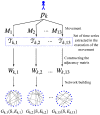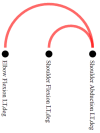NE-Motion: Visual Analysis of Stroke Patients Using Motion Sensor Networks
- PMID: 34208996
- PMCID: PMC8271972
- DOI: 10.3390/s21134482
NE-Motion: Visual Analysis of Stroke Patients Using Motion Sensor Networks
Abstract
A large number of stroke survivors suffer from a significant decrease in upper extremity (UE) function, requiring rehabilitation therapy to boost recovery of UE motion. Assessing the efficacy of treatment strategies is a challenging problem in this context, and is typically accomplished by observing the performance of patients during their execution of daily activities. A more detailed assessment of UE impairment can be undertaken with a clinical bedside test, the UE Fugl-Meyer Assessment, but it fails to examine compensatory movements of functioning body segments that are used to bypass impairment. In this work, we use a graph learning method to build a visualization tool tailored to support the analysis of stroke patients. Called NE-Motion, or Network Environment for Motion Capture Data Analysis, the proposed analytic tool handles a set of time series captured by motion sensors worn by patients so as to enable visual analytic resources to identify abnormalities in movement patterns. Developed in close collaboration with domain experts, NE-Motion is capable of uncovering important phenomena, such as compensation while revealing differences between stroke patients and healthy individuals. The effectiveness of NE-Motion is shown in two case studies designed to analyze particular patients and to compare groups of subjects.
Keywords: graph learning; set theory; stroke; visual analytics; visualization.
Conflict of interest statement
The authors declare no conflict of interest. The funding agencies had no role in the design of the study; in the collection, analyses, or interpretation of data; in the writing of the manuscript, or in the decision to publish the results.
Figures








References
-
- Warlow C.P., Van Gijn J., Dennis M.S., Wardlaw J.M., Bamford J.M., Hankey G.J., Sandercock P.A., Rinkel G., Langhorne P., Sudlow C., et al. Stroke: Practical Management. John Wiley & Sons; Hoboken, NJ, USA: 2011.
-
- Fugl-Meyer A.R., Jääskö L., Leyman I., Olsson S., Steglind S. The post-stroke hemiplegic patient. 1. A method for evaluation of physical performance. Scand. J. Rehabil. Med. 1975;7:13–31. - PubMed
-
- Del Din S., Patel S., Cobelli C., Bonato P. Estimating Fugl-Meyer clinical scores in stroke survivors using wearable sensors; Proceedings of the 2011 Annual International Conference of the IEEE Engineering in Medicine and Biology Society; Boston, MA, USA. 30 August–3 September 2011; pp. 5839–5842. - PubMed
-
- Wang J., Yu L., Wang J., Guo L., Gu X., Fang Q. Automated Fugl-Meyer assessment using SVR model; Proceedings of the 2014 IEEE International Symposium on Bioelectronics and Bioinformatics (IEEE ISBB 2014); Chung Li, Taiwan. 11–14 April 2014; pp. 1–4.
MeSH terms
Grants and funding
LinkOut - more resources
Full Text Sources
Medical

